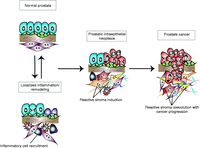The reactive stroma microenvironment and prostate cancer progression
- David A Barron* and
- David R Rowley*
- Department of Molecular and Cellular Biology, Baylor College of Medicine, One Baylor Plaza, 325D, mailstop BCM130, Houston, Texas 77030, USA
- (Correspondence should be addressed to D R Rowley; Email: drowley{at}bcm.edu)
-
Figure 1
Cellular components of the human prostate gland. Secretory epithelial cells are situated on a basal lamina/basement membrane and secrete products into the acinar lumen. Basal cells and sparse neuroendocrine cells are also present in the epithelial compartment. The stromal compartment immediately surrounding the epithelial acini is complex and consists of smooth muscle, trace fibroblasts, blood vessels, autonomic nerve fibers, inflammatory cells, and extracellular matrix components.
-
Figure 2
Stromal cell phenotypes and associated markers. Stromal cell populations found in the prostate gland and other epithelial-lined organs are distinguished based on their morphology and expression of marker proteins. Shown here are three major stromal cell types and associated markers used to identify them in the prostate gland. Importantly, these markers are not lineage specific.
-
Figure 3
Prostate gland homeostasis and reactive stroma formation in cancer. The histopathological changes in inflammatory conditions of the prostate (i.e. proliferative inflammatory atrophy or PIA) are similar to changes observed in wound repair. Similarly, prostate cancer can be viewed as an equivalent of chronic wounding with a prototypical reactive stroma response. It is hypothesized that the inflammatory cell populations recruited to lesions work coordinately with factors secreted by the carcinoma cells to generate a reactive stroma response. As cancer progresses, this reactive stroma coevolves with foci of adjacent carcinoma. The net effect is likely to be tumor promoting within the context of early and organ-confined disease.
-
Figure 4
Model of potential origin and regulators of reactive stroma. It is hypothesized that reactive stroma in prostate cancer may be derived from both bone marrow-derived cells as well as non-marrow sources. The latter cell population is most likely tissue-resident mesenchymal/stromal stem cells or existing fibroblasts. Carcinoma-produced factors, including TGF-β, have the potential to reach and regulate the stromal compartment when the epithelial layer integrity and/or basement membrane integrity is disrupted during cancer progression.
- © 2012 Society for Endocrinology













